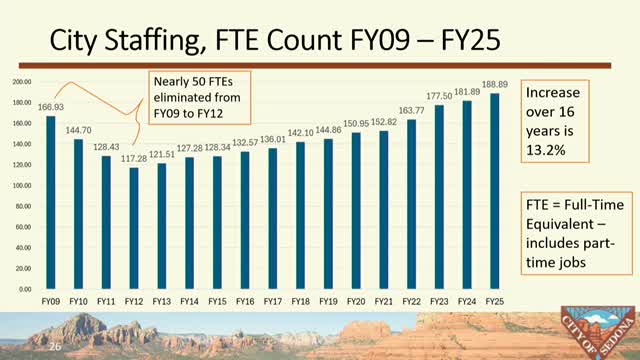Council and staff debate staffing levels, pay study and pace of restoring FTEs
April 30, 2025 | Sedona, Yavapai County, Arizona
This article was created by AI summarizing key points discussed. AI makes mistakes, so for full details and context, please refer to the video of the full meeting. Please report any errors so we can fix them. Report an error »

Sedona councilors pressed city managers and department heads about staffing growth since the Great Recession, the value of restored positions, and the results of a recent salary study that staff folded into the FY26 budget.
Councilor Brian Fultz and others asked for a clearer accounting of which roughly 50 full-time-equivalent positions eliminated during fiscal 2009–2012 had been restored and what work those positions did. Public-works staff said the biggest impact during the earlier cuts was to capital project management; essential services such as pavement maintenance continued but project management capacity fell. The city manager and department heads said many positions were later reintroduced because of new or expanded services — for example, adding sustainability and tourism roles, administering a municipal transit program, and creating housing initiatives.
The council repeatedly requested a more transparent history of budget decisions that added positions back over time. Spicher told council she could compile a “waterfall” or history of decision-package choices to show which years and decisions restored staff.
Salary study and FY26 effects: staff said the FY26 base includes adjustments from a citywide salary and market study. Whitehorn said the study adjusted pay ranges and that not every incumbent will receive the full range adjustment; the budget reflects personnel costs where an individual equity adjustment was required. Staff scheduled a presentation from Human Resources to explain the salary-study methodology and scope so councilors can see how personnel changes affected department personnel lines and overall costs.
Why it matters: Staffing and compensation choices affect service levels, recruitment and retention. Councilors emphasized that the public needs clearer context when head-count numbers are cited in news or public comment.
Councilor Brian Fultz and others asked for a clearer accounting of which roughly 50 full-time-equivalent positions eliminated during fiscal 2009–2012 had been restored and what work those positions did. Public-works staff said the biggest impact during the earlier cuts was to capital project management; essential services such as pavement maintenance continued but project management capacity fell. The city manager and department heads said many positions were later reintroduced because of new or expanded services — for example, adding sustainability and tourism roles, administering a municipal transit program, and creating housing initiatives.
The council repeatedly requested a more transparent history of budget decisions that added positions back over time. Spicher told council she could compile a “waterfall” or history of decision-package choices to show which years and decisions restored staff.
Salary study and FY26 effects: staff said the FY26 base includes adjustments from a citywide salary and market study. Whitehorn said the study adjusted pay ranges and that not every incumbent will receive the full range adjustment; the budget reflects personnel costs where an individual equity adjustment was required. Staff scheduled a presentation from Human Resources to explain the salary-study methodology and scope so councilors can see how personnel changes affected department personnel lines and overall costs.
Why it matters: Staffing and compensation choices affect service levels, recruitment and retention. Councilors emphasized that the public needs clearer context when head-count numbers are cited in news or public comment.
View full meeting
This article is based on a recent meeting—watch the full video and explore the complete transcript for deeper insights into the discussion.
View full meeting
